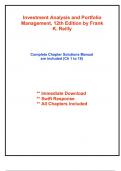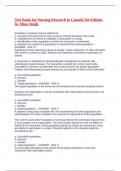Investment Analysis and Portfolio
Management, 12th Edition by Frank
K. Reilly
Complete Chapter Solutions Manual
are included (Ch 1 to 18)
** Immediate Download
** Swift Response
** All Chapters included
,Solution and Answer Guide
FRANK K. REILLY, KEITH, C. BROWN, SANFORD J. LEEDS, INVESTMENT ANALYSIS & PORTFOLIO MANAGEMENT, 12TH
EDITION, © 2025, 9780357988176; CHAPTER 1: THE INVESTMENT SETTING
TABLE OF CONTENTS
Answers to Questions .......................................................................................................................... 1
Answers to Problems ........................................................................................................................... 5
Appendix 1: Answers to Problems ........................................................................................................ 9
ANSWERS TO QUESTIONS
1. When an individual’s current money income exceeds his or her current consumption desires, he or
she saves the excess. Rather than keeping these savings in his or her possession, the individual may
consider it worthwhile to forego immediate possession of the money for a larger future amount of
consumption. This trade-off of present consumption for a higher level of future consumption is the
essence of investment.
An investment is the current commitment of funds for a period of time in order to derive a future
flow of funds that will compensate the investor for the time value of money and the expected rate
of inflation over the life of the investment, as well as provide a premium for the uncertainty
associated with this future flow of funds.
2. Students in general tend to be borrowers because they are typically not employed and thus have no
income (or they are employed with limited income), but they obviously consume and have
expenses. The usual intent is to invest the money borrowed in order to increase their future income
stream from employment. In other words, students expect to receive a better job and higher
income due to their investment in education.
3. In the 20–30-year-old segment, an individual would tend to be a net borrower because s/he is in a
relatively low-income bracket and has several expenditures, including automobile(s) and durable
goods. In the 30–40-year-old segment, an individual would likely dissave, or borrow, as his or her
expenditures would increase with the advent of family life, and conceivably, the purchase of a
house. In the 40–50-year-old segment, the individual would probably be a saver because income
would increase substantially with no increase in expenditures. Between the ages of 50 and 60, the
individual would typically be a strong saver because income would continue to increase and by now
the couple would be “empty-nesters.” After this, depending upon when the individual retires, the
individual would probably be a dissaver as income decreases (transition from a regular income to
income from a pension). Of course, the earlier that this individual can start saving, the better off
s/he will be. Your goal should be to start saving once you finish school.
4. The saving–borrowing pattern would vary by profession to the extent that compensation patterns
, vary by profession and time spent in school also varies. For most white-collar professions (for
example, lawyers), income would tend to increase with age. Thus, lawyers would tend to be
borrowers in the early segments (when income is low) and savers later in life. Alternatively, for blue-
collar professions (for example, plumbers), in which skill is often physical, compensation tends to
remain constant or decline with age. Thus, plumbers would tend to be savers in the early segments
and dissavers in the later segments (when their income declines).
5. The difference is because of the definition and the measurement of return. In the case of the Wall
Street Journal, they only refer to the current dividend yield on common stocks, whereas in the case
of the University of Chicago studies, they talk about the total rate of return on common stocks,
which is the dividend yield plus the capital gain or loss yield during the period. In the long run, the
dividend yield has been 4–5 percent, and the capital gain yield has averaged about the same. In
recent years, the dividend yield has been closer to 2 percent (and the amount of share repurchases
has increased). Therefore, it is important to compare alternative investments based on total return.
6. The variance of expected returns represents a measure of the dispersion of actual returns around
the expected value. Everything else remaining constant, the larger the variance is, the greater the
dispersion of expectations and the greater the uncertainty, or risk, of the investment. The purpose
of the variance is to help measure and analyze the risk associated with a particular investment. A
greater variance implies a greater possibility of returns that are very different from your expected
return—and that is risk.
7. An investor’s required rate of return is a function of the economy’s risk-free rate (RFR), an inflation
premium that compensates the investor for the loss of purchasing power, and a risk premium that
compensates the investor for taking the risk. The RFR is the pure time value of money and is the
compensation an individual demands for deferring consumption. More objectively, the RFR can be
measured in terms of the long-run real growth rate in the economy because the investment
opportunities available in the economy influence the RFR. We think of Treasury yields (i.e., the cost
of government borrowing) as the RFR. The inflation premium is the additional protection an
individual requires to compensate for the erosion in purchasing power resulting from increasing
prices. Because the return on all investments is not certain as it is with T-bills, the investor requires a
premium for taking on additional risk. The risk premium can be examined in terms of business risk,
financial risk, liquidity risk, exchange rate risk, and country risk.
8. The three main factors that influence the nominal RFR are the real growth rate of the economy, the
expected rate of inflation, and liquidity (i.e., supply and demand for capital in the economy). The
real growth rate and inflationary expectations have positive relationships with the nominal RFR. In
other words, the higher the real growth rate, the higher the nominal RFR, and the higher the
expected level of inflation, the higher the nominal RFR. Liquidity has an inverse relationship with the
nominal RFR, meaning that lower liquidity results in higher yields.
It is unlikely that the economy’s long-run real growth rate will change dramatically during a business
cycle. However, liquidity depends upon the government’s monetary policy and would change
depending upon what the government considers to be the appropriate stimulus. Besides, the
demand for business loans would be greatest during the early and middle parts of the business
, cycle. Inflation can also change significantly during a business cycle.
9. The five factors that influence the risk premium on an investment are business risk, financial risk,
liquidity risk, exchange rate risk, and country risk.
Business risk is a function of sales volatility and operating leverage, and the combined effect of the
two variables can be quantified in terms of the coefficient of variation of operating earnings.
Financial risk is a function of the uncertainty introduced by the financing mix. The inherent risk
involved is the inability to meet future contractual payments (interest on bonds, etc.) or the threat
of bankruptcy. Financial risk is measured in terms of a debt ratio (for example, debt/equity ratio)
and/or the interest coverage ratio. Liquidity risk is the uncertainty an individual faces when he or
she decides to buy or sell an investment. The two uncertainties involved are: (1) how long it will take
to buy or sell this asset and (2) what price will be received. The liquidity risk on different
investments can vary substantially (for example, real estate versus T-bills). Exchange rate risk is the
uncertainty of returns on securities acquired in a different currency. The risk applies to the global
investor or multinational corporate manager who must anticipate returns on securities in light of
uncertain future exchange rates. A good measure of this uncertainty would be the absolute volatility
of the exchange rate or its beta with a composite exchange rate. Country risk is the uncertainty of
returns caused by the possibility of a major change in the political or economic environment of a
country. The analysis of country risk is much more subjective and must be based on the history and
current environment in the country.
10. The increased use of debt increases the fixed interest payment. Since this fixed contractual payment
will increase, the residual earnings (net income) will become more variable. The required rate of
return on the stock will increase since the financial risk (as measured by the debt/equity ratio) has
increased.
11. According to the Capital Asset Pricing Model (which will be discussed in later chapters), all securities
are located on the Security Market Line, with securities’ risk on the horizontal axis and securities’
expected return on the vertical axis. As to the locations of the five types of investments on the line,
the U.S. government bonds should be located to the left of the other four, followed by the U.K.
government bonds, low-grade corporate bonds, common stock of large firms, and common stocks
of Japanese firms. The U.S. government bonds have the lowest risk and the required rate of return
simply because they virtually have no default risk at all. The U.K. government bonds are perceived to
be default risk-free but expose the U.S. investor to exchange rate risk. Low-grade corporates contain
business, financial, and liquidity risks but should be lower in risk than equities. Japanese stocks are
riskier than U.S. stocks due to exchange rate risk.






